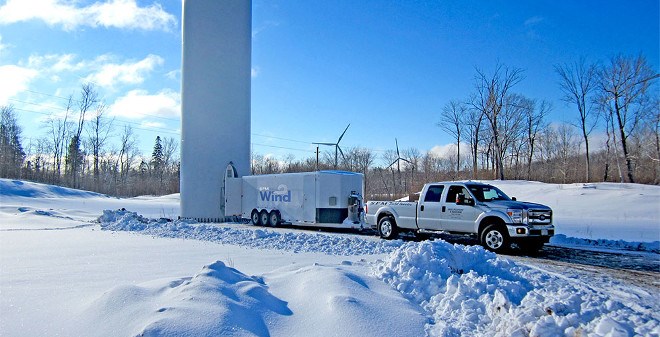By the time Soo Foundry and Machine started servicing the wind industry, the Sault Ste. Marie fabrication company had already been working on their customers’ hydroelectric facilities for more than 20 years.
But when Brookfield Power built the 126-turbine Prince Wind Farm just north of the city in 2006, Brookfield contracted Soo Foundry to do all its maintenance work.
That was the catalyst for the company to branch into wind, and SFM Wind was born.
A division of Soo Foundry, SFM Wind completes up-tower gearbox repairs, gearbox oil changes, blade inspections, and more.
It additionally rents out Sage Oil Vac equipment for doing oil exchanges, and trains workers on the equipment. Bob Cohen, president of Soo Foundry and SFM Wind, said the company has now serviced wind turbines for major companies from coast to coast across Canada.
“Wind energy was kind of a natural progression from hydroelectric,” he said. “A lot of the owners are utilities or major companies, and they have both of those types of assets.”
Two years ago, after realizing there was a North American shortage of gearbox maintenance technicians, the company became certified as an approved Winergy service provider.
Winergy is the biggest manufacturer of gearboxes in the world, cornering about 70 per cent of the wind turbine gearbox market.
“Right now, there are only two service providers for Winergy in Canada: one is very far east, and us in central Canada,” said Ivan Brlecic, SFM’s operations manager. “So there’s a lot of demand for this type of work.”
As the wind turbines age, more maintenance work is required to keep them running smoothly, he said. In the Sault area alone, SFM does work for Brookfield, Blue Earth and Capstone.
The length required for the job is contingent on the work being done.
“It all depends on what type of work you’re performing and where you are,” Brlecic said. “There are towers that can be completed in one day, but there’s a job that would take a whole week to get it done.”
One job sent the crew to Alberta for 10 months.
The industry has a high turnover rate, since it involves visiting remote locations and a lot of travel, and techs are often working in inclement weather. It’s also a high-risk industry, since technicians are doing what’s called “up-tower” maintenance — the technicians ascend the tower to do the work in situ rather than remove and lower the components to the ground before servicing them.
Technicians are sent out of the country for training, as the specialty training recognized in the industry and required by clients isn’t available in Sault Ste. Marie.
“It’s very tactical work, and there’s a lot of safety training,” Cohen said. “You have to appreciate that you’re working at 300 feet in the air, so you’re changing oil and you’re doing mechanical work at that height.”
All Soo Foundry employees are also SFM Wind employees. Brlecic serves as operations manager, while Rick Oliver is SFM’s field manager, and the millwrights and millwright apprentices to do the repair work.
As the wind industry evolves, so do the demands from clients who want turbine maintenance done more cheaply. SFM is constantly doing research and development into how to make that happen.
“The market is changing daily; all the owners are looking at ways to save money, so we need to be able to adapt very quickly to their demands,” Brlecic said. “So it's involving a lot of travelling, not just for the wind techs, but for the office staff that are doing the sales calls.”
The changing market also means opportunities for company growth.
Cohen said SFM is now looking to the export market — being located on the Canada-U.S. border puts the company at an advantage — and any growth could be accompanied by new hires.
And he’s optimistic about what the future of the wind industry holds, as wind farms move away from purchase-power agreements and look for ways to make the wind turbine technology more efficient.
Customers are also seeking cleaner sources of energy, which will drive up demand and help drive down the cost.
“I don’t really see much alternative, because if you’re going to get away from fossil fuels and you want clean energy, you don’t have a whole lot of choices,” he said. “So you’re going to have to drive those costs down and make it as efficient as possible.”




